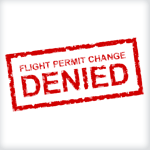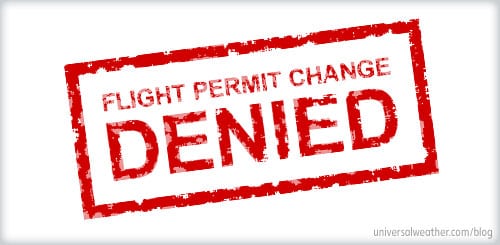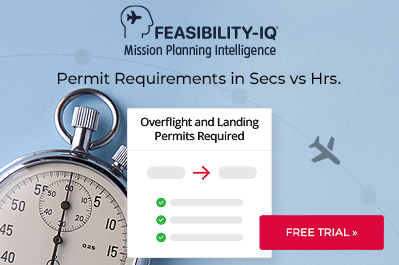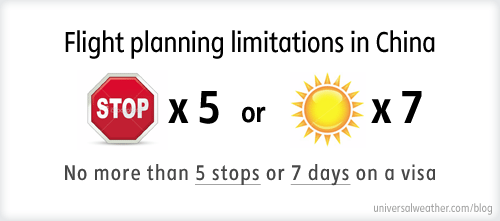13 Things to Know About Overflight and Landing Permits in China

February 6, 2014: To see the updated regulations regarding China permits, please see our articles: "China Overflight and Landing Permits – Part 1: Changes in Lead Times and Revisions" and "China Overflight and Landing Permits – Part 2: Permit Considerations."
This business aviation blog post is part of a series on operating to China and continues from our last post entitled: Flight Ops to China: Tips for Arranging Security, Ground Transport and In-flight Catering.
Operating permits for China vary in complexity and lead time. However, they have become more streamlined within the past few years. Two factors have played into this trend: 1) Chinese authorities have a greater appreciation of the value of business aviation to the broader economy, and 2) an increasingly locally-based fleet of Chinese-registered business aircraft has improved overall familiarity with operator needs. Nonetheless, we recommend you utilize experienced 3rd-party providers and provide as much lead time as possible when planning a trip to China to ensure a smooth and trouble-free result.
1. Plan on applying for permits as early as possible
The Civil Aviation Administration of China (CAAC) requires at least five working days to process landing permits, regardless of the type of flight. Also, lead time of at least 96 hours is required for overflight permits – for both private non-revenue and charter (non-scheduled commercial) flights. It may be possible to obtain a landing or overflight permit within the 96-hour lead time, but that is at the discretion of the CAAC. Keep in mind that you’ll have to provide the CAAC with a “sponsor letter” for each trip to China. Also note that tourist flights aren’t permitted into the country. If you’re a first-time operator to China (or working with a new sponsor), we recommend you begin the permit process as early as possible, especially if you plan on making multiple stops within the country.
2. Sponsor letters are required with all landing permit applications
To obtain a China landing permit, you’ll need to provide specific information, depending on the type of flight. Among the types of information required are a schedule, a crew and passenger list and a sponsor letter for the CAAC. Your local sponsor, who agrees to take responsibility for you while in China, must be based at one of the cities you’ll be visiting. Also, the letter must be on company letterhead, listing a contact person and his or her contact information. Please note that a sponsor may not be a tourist company or a hotel. The CAAC may or may not contact your sponsor to verify the information. A single sponsor letter will usually cover your itinerary within China for up to five stops but will not cover multiple trips to China. For a schedule that has more than five stops, the CAAC may require you to submit a sponsor letter for each stop, one from a sponsor based in each city you stop in.
3. Be careful to obtain correct crew visas, as this continues to be a problem for operations to China
All crew members operating to or from China will require a “C”-type crew visa. There have been cases of crew coming to China without the correct crew visa. The result can be a fine or deportation. Multi-entry crew visas are obtainable. In some cases, annual China crew visas might be an option. Multi-entry visas are based on need. You must show a multi-operation schedule, state your reasons on company letterhead or prove that you need to enter China more than once.
In addition to the above, a crew member may not arrive or depart China with a crew visa as a passenger on a commercial flight. So, if you are flying to China commercially to pick up your corporate aircraft, you’ll require either a tourist or business visa on arrival and a crew visa on departure. Keep in mind that a crew visa is usually only valid for seven days in the country. If you plan to stay longer, you may have to depart China and fly to Hong Kong to renew your crew visa and obtain a tourist visa to reenter China. Correct visa type is a critical but often overlooked issue in China and continues to create issues for corporate pilots. When flying commercially into or out of the country, it’s best to always advise your ground handler of the type of Chinese visa each crew member is carrying in order for them to advise local authorities in advance. Please note that additional documentation may be required by local authorities if you have a “C”-type visa to enter or depart the country commercially (this is for relief crew only). For this reason and because regulations may change at a moment’s notice, we recommend you contact your 3rd-party provider for more information.
Certain nationalities (including Russians and Japanese) may obtain visas on arrival at several selected cities in China, including Beijing and Shanghai. However, this option is not available to U.S. citizens and many other nationalities.
| Visa on arrival for | Nationality | ZBAA/ Beijing | ZSSS/ Hongqiao | ZGGG/ Guangzhou | ZGSZ/ Shenzhen | ZPPP/ Kunming |
|---|---|---|---|---|---|---|
| Information is current as of January 31, 2012. Please check with your international trip services provider or local ground handler for any changes when planning your next trip. | ||||||
| Pax | Russia | YES | YES | YES | YES
(male only, n/a for female)
|
N/A |
| Japan | NOT NEEDED FOR VISITS WITHIN 15 DAYS | NOT NEEDED FOR VISITS WITHIN 15 DAYS | NOT NEEDED FOR VISITS WITHIN 15 DAYS | NOT NEEDED FOR VISITS WITHIN 15 DAYS | NOT NEEDED FOR VISITS WITHIN 15 DAYS | |
| British | YES | YES | N/A | YES | N/A | |
| Australia | YES | YES | N/A | YES (but n/a for immigration) |
N/A | |
| German | YES | YES | N/A | YES | N/A | |
| US | N/A | N/A | N/A | N/A | N/A | |
| Crew | Russia | YES | N/A | N/A | YES (male only, n/a for female) |
N/A |
| Japan | YES | N/A | N/A | YES | N/A | |
| British | YES | N/A | N/A | N/A | N/A | |
| Australia | YES | N/A | N/A | N/A | N/A | |
| German | YES | N/A | N/A | N/A | N/A | |
| US | N/A | N/A | N/A | N/A | N/A | |
4. You will be limited on the number of stops you can make in China on a single trip
Permitted stops in China typically max out at five per trip. If you’re planning more than five stops, it’s best to schedule an in-between stop at Hong Kong (VHHH) or Seoul, South Korea (RKSI or RKSS). Your 3rd-party provider will help you manage expectations so that you’re not applying for something that may eventually require a revision to your schedule.
5. Know the difference between “charter” and “private/business” flight status within China
If you’re operating an aircraft with more than 29 seats, you’ll be deemed a charter (non-scheduled commercial) flight and face additional permit requirements, including providing a charter agreement, Air Operator Certificate (AOC) and aircraft interior configuration. All aircraft at or under the 29-seat capacity are treated as private/business flights, even if you are actually operating as a charter (non-scheduled commercial). Cabotage is seldom an issue in China but it must still be requested and confirmed every time to avoid issues. Keep in mind that the CAAC will only provide permits for business flights, as tourism flights are not permitted within China at this time.
6. Expect costs of operating in China to be high
The cost of operating in China may be relatively high. Government fees, navigation charges, airport fees and handling costs can all be relatively expensive. You’ll also pay the CAAC a “compensation fee” of about $3,000 for every entry into China.
Air navigation fees are currently about $0.44 cents per kilometer. A new category – smaller business jets – was recently introduced in China. Navigation fees are currently at $0.22 cents per kilometer, but this will unfortunately not benefit the majority of international corporate operators.
We recommend you obtain a breakdown of all charges from your 3rd-party provider to get an overview of all the costs for your aircraft and particular operation.
7. You may be permitted to operate directly between China and Taiwan (depending on registration of aircraft)
While direct operations between China and Taiwan have in some cases been permitted, permits are only being issued to China- or Taiwan-registered aircraft. For the moment, at least, there are no exceptions to this rule, but that may change at a moment’s notice.
8. You may not get the routings you request
After receiving your permit request, the CAAC may confirm the permit with a different routing than you originally requested. As routing changes may be small, it’s important for you and your 3rd-party provider to carefully review all clearances and confirm that the routing you filed is what the CAAC approved.
9. Multiple schedule changes may result in a permit denial

In recent years, the CAAC has streamlined the permit process for operators traveling to China, allowing some operational flexibility. However, they are particular about multiple changes. If you initiate too many changes, the CAAC may reject your revision request. There have been cases where the CAAC has approved a requested change but forbade any more changes. One permit change is usually not an issue. Additionally, the CAAC requires three working days to process schedule or routing changes, but they may approve the revision within a shorter timeframe at their discretion.
10. Follow overflight and landing permit clearances accurately
Operators who do not follow overflight and landing permit clearances accurately may encounter difficulties. An aircraft may be returned to its point of origin if the crew arrives at a point of entry into China different from the one provided on the overflight or landing permit confirmation. In China, you need to fly your assigned and cleared route precisely as provided on the confirmation.
It’s important to remember that while you may be able to secure a China permit within the official lead time, you’ll still have to consider slot and airway restrictions to and from China. Give yourself sufficient lead time, as flight permits for surrounding airspace may take longer to process than your China overflight or landing permit.
11. You may experience airway restrictions and altitude hold-downs
Airway restrictions exist throughout China, with many airways only available to Chinese scheduled commercial carriers. When departing China, particularly to the east, you can expect altitude hold-downs, so plan aircraft fuel upload and range accordingly. Chinese air traffic control has been trying to limit the hold-downs when possible, but you can’t expect all altitudes requested. Also, please note that direct routings are not available.
12. Post-trip requirements and delayed invoices are minimal when operating to China
There are no follow-up requirements to comply with post-trip regarding sponsor letters or related government requirements. Once the sponsor letter is issued and accepted, the task is considered completed.
Assuming that you’re working with a 3rd-party provider and local ground handler, all ground handling, ground services and airport fees will have been looked after throughout the trip. You’ll know all charges and navigation fees pre-departure.
13. What is the invoice process for the CAAC?
Tong Da Air Service is authorized by the CAAC to collect the en-route charge, government permission fees, compensation charges and the service charges. See below for more details.
Tong Da will send the invoices by SITA monthly. Below is an example:
| Quoted Message ID: BJSTTCA 060736/PANG QUOTE 034 000 060737 DEC 10 QD XXXXXXX XXXXXXX XXXXXXX . XXXXXXX XXXXXXX XXXXXXX XXXXXXX XXXXXXX .BJSTTCA 060736/PANG ATTN: FLT OPS / XXXXXXXXXXXXXX FINANCE DEPT. / UNIVERSAL AVIA HOU USA COPY: XXXXXXXXXXXXX FROM: TONG DA AIR SERVICE, CHINA E-MAIL:TONGDA@TDAS-INTL.COM RE THE XXXXXXXXX RJAA-ZBAA-KOAK 03-05NOV2010 WITH THE PERMISSION NUMBER XXX/XXXX/XXXX CAACTHE INVOICE TDAS/103027 AS FLWS:1.THE AIR NAVIGATION FACILITIES FEES USD1,130.00 2.THE COMPENSATION FEES USD3,000.00 3.THE SERVICE FEES USD1,200.00 TOTAL: USD5,330.00 THE DETAILS FOR PAYMENT BY BANK WIRE AS FLWS : ACCOUNTING: TONGDA AIR SERVICE ACCOUNT NBR: #################### BANK NAME: XXXXXXXXXXXXXX XXXXXXXXXXXXXXXXXXXXXXXX SWIFT CODE: XXXXXXXXXXXXXXXXXXXXXXXXXXXX MNY TKS FOR YR KINDLY ATTN N COOP. BEST REGARDS / PANG / TONGDA AIR SERVICE / CHINA UNQUOTE |
Questions?
If you have any questions about this article or would like assistance planning your next trip to China, contact Christine Vamvakas christinevamvakas@univ-wea.com.
Later we’ll discuss flight planning in China.





